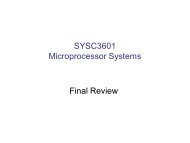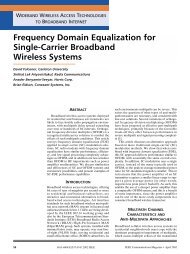Image Reconstruction for 3D Lung Imaging - Department of Systems ...
Image Reconstruction for 3D Lung Imaging - Department of Systems ...
Image Reconstruction for 3D Lung Imaging - Department of Systems ...
You also want an ePaper? Increase the reach of your titles
YUMPU automatically turns print PDFs into web optimized ePapers that Google loves.
configuration gave the worse overall per<strong>for</strong>mance: a conductivity decrease resulted in images<br />
<strong>of</strong> a conductivity increase. The Planar, Planar-Offset, and Zigzag EP configurations were<br />
able to reconstruct a circular/spherical image without introducing image shape artefacts. In<br />
all cases the centre <strong>of</strong> mass <strong>of</strong> the reconstructions were rotated in the axial plane by about<br />
20 ◦ . Since EIT is expected to be used <strong>for</strong> functional imaging as opposed to anatomical<br />
imaging, the rotation position error may not be important as long as the magnitude <strong>of</strong> the<br />
conductivity change is accurate.<br />
6.3.4 Electrode Position Errors - Electrode Plane Separation Error<br />
Radial PE, Vertical PE and Resolution are not significantly affected by electrode plane<br />
separation errors <strong>for</strong> any <strong>of</strong> the EP configurations. All <strong>of</strong> the per<strong>for</strong>mance measures degraded<br />
smoothly. This can be seen with some representative plots in figures 6.10(a) to<br />
6.10(c). Qualitatively, all configurations produced vertically elongated images with the<br />
Square and the two Opposite EP configurations being most affected, Zigzag and Zigzag-<br />
Offset configurations less so, and the Planar and Planar-Offset EP configurations the least.<br />
For contrasts located in the end zones, the Zigzag, Zigzag-Offset, and Square configurations<br />
Phantom Height (%)<br />
90<br />
80<br />
70<br />
60<br />
50<br />
40<br />
30<br />
20<br />
10<br />
Error Free Response<br />
Degradation <strong>of</strong> Vertical Position Error<br />
as Electrode Plane Separation Error<br />
increases<br />
10 20 30 40 50 60 70 80 90<br />
<strong>Image</strong> Height (%)<br />
(a) Planar, Vertical Position Error<br />
Phantom Height<br />
25<br />
20<br />
15<br />
10<br />
5<br />
Phantom Height<br />
25<br />
20<br />
15<br />
10<br />
5<br />
Error Free Resolution<br />
-0.2 -0.15 -0.1 -0.05 0<br />
Radial Error (%)<br />
Degrading Resolution as<br />
electrode plane error increases<br />
0<br />
0.36 0.38 0.4 0.42 0.44 0.46 0.48<br />
Resolution (BR)<br />
0.5 0.52 0.54 0.56<br />
(b) Zigzag, Resolution<br />
Error Free<br />
Radial Position Error<br />
Degrading Radial Position Error<br />
due to increasing<br />
Electrode Plane Separation Error<br />
(c) Planar-Opposite, Radial Position Error<br />
Figure 6.10: Degradation <strong>of</strong> selected per<strong>for</strong>mance measures <strong>for</strong> selected configurations due<br />
to electrode plane separation error. The Error Free curves represent no electrode plane<br />
separation error. The dotted curves represent increasing electrode plane separation to a<br />
maximum <strong>of</strong> 10 cm error represented by the red solid line.<br />
show a swirling artefact while the Opposite EP configurations show an extensive vertical<br />
lengthening <strong>of</strong> the reconstructed contrast. The Planar and Planar-Offset EP configurations<br />
90





